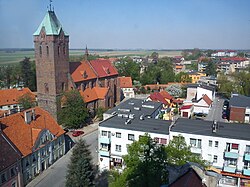Top Qs
Timeline
Chat
Perspective
Byczyna
Place in Opole Voivodeship, Poland From Wikipedia, the free encyclopedia
Remove ads
Byczyna [bɨˈt͡ʂɨna] (Latin: Bicina, Bicinium; German: Pitschen) is a town in Kluczbork County, Opole Voivodeship, in southern Poland,[2] with 3,490 inhabitants as of December 2021.[1]
Remove ads
Etymology
The name comes from the Old Polish word byczyna, which means a place for breeding and grazing bulls.[3]
History
Summarize
Perspective
The town of Byczyna was first mention in 1054 when it temporarily served as the capital of the Bishopric of Wrocław. It was part of Poland and during its fragmentation period it was part of the duchies of Silesia, Głogów and Namysłów, before it was again under direct rule of Polish King Casimir III the Great from 1341 to 1348.[3] It was granted town rights before 1268.[4] In 1356 it passed to the Czech Crown Lands, and it soon returned under the rule of local Polish dukes of the Piast dynasty, as part of the duchies of Świdnica, Opole, Brzeg, Oleśnica, again Brzeg, Opole and finally Legnica until 1675.[3] Afterwards it was incorporated into the Habsburg-ruled Czech Kingdom. It was a border town,[5] located near Poland.

The Battle of Byczyna took place nearby between Maximilian III, Archduke of Austria, who was elected as king of Poland, and Sigismund III Vasa who also was elected as king, on January 24, 1588. Maximilian was defeated. He surrendered and went to imprisonment. The German author Gustav Freytag[6] reports in his memories about yearly border violations at Byczyna. During the Thirty Years' War the town was occupied by the Saxons in 1633 and Swedes in 1646.[3] In the 16th century, a Polish school was established, which flourished in the 17th century, and from 1657 to 1661 its rector was Byczyna-born Polish scholar and translator John Herbinius.[3]
After the Prussian annexation in 1742, Byczyna, under the Germanized name Pitschen, entered a period of Germanisation, and the local school slowly diminished.[3] In 1757 the town suffered the largest fire in its history.[3] Despite those circumstances, in the 19th century, the town was still largely inhabited by Poles. After World War I and the rebirth of independent Poland, Germany introduced a number of restrictions, including a state of emergency, to hinder the self-organization of local Poles.[3] In the interwar period the town remained part of Germany and has been affected by a recession.[3] Smuggling became widespread, which ended only during the concentration of German troops before the invasion of Poland and start of World War II in 1939.[3] In 1945, the population was mostly evacuated before the advancing Eastern Front, with only a few hundred people remaining, mostly local Poles and Polish forced laborers, of which over 200 were massacred by Soviet troops,[7] after their capture of the town on 18 January 1945.[3] After the defeat of Nazi Germany in 1945, Byczyna was reintegrated with Poland. Soon the Polish railway and post were organized as the first post-war Polish institutions in the town.[3]
Remove ads
Notable people
- Piotr of Byczyna, medieval Polish writer, author or co-author of the 14th-century Polish chronicle Chronica principum Poloniae
- Eliasz Kreczmar (von Löven), physician and astronomer, married Maria Cunitz
- Maria Cunitz (1610–1664), astronomer, died at Pitschem
- Jan Herbinius (1627–1679), Polish scholar and translator
- Adam Quasius (1673–1736), theologian and Deacon at St. Elisabeth Church in Wrocław
- Piotr Steinkeller (1799–1854), industrialist, "Polish King of Zinc", exploited local ore deposits
- Jan Dzierżon (1811–1906), pioneering Polish apiarist, attended school in Byczyna
- Martin Kutta (1867–1944), mathematician
Twin towns – sister cities
Gallery
- Medieval town walls with the Eastern (or "Polish") Tower
- Western (or "German") Tower
- Baroque Holy Trinity church
- The Saint Nicolaus evangelic church
References
External links
Wikiwand - on
Seamless Wikipedia browsing. On steroids.
Remove ads









